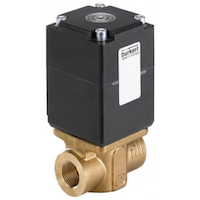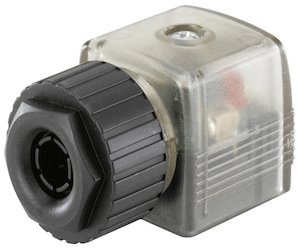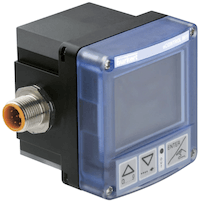Burkert 2875 Proportional Solenoid Valve - How They Work

Figure 1: Burkert 2875 solenoid valve
The Burkert 2875 is a normally closed (NC) plunger valve that uses a PWM signal for precise control between fully open and closed positions. It features an elastomeric seat seal for tight closure and orifice sizes from 2 to 9.5 mm. The frictionless plunger allows excellent proportional control. Designed for neutral gases and liquids, it is available in brass, aluminum, and stainless steel.
Table of contents
- Is Burkert 2875 the right valve for you?
- Operating principle and design
- Approvals for Burkert 2875 valve
- Features
- What other products can it be used with?
Buy Burkert 2875 Online Now!
Is Burkert 2875 the right valve for you?
This solenoid valve is designed for proportional flow control. It is designed to be operated with a PWM controller, like the Burkert type 8605 or 8611. The valve provides easy integration with other Burkert products that satisfy mounting and configuration requirements thus, decreasing installation time and optimizing performance. Additionally, the valve is well protected from the environment with a brass or stainless-steel body and IP65 rating.
The Burkert 2875 valve is designed to perform highly rigorous flow control tasks and is reliable for neutral fluids and resistant to many chemicals. The direct operating function enables the valve to work without a minimum differential pressure. This valve might be the right choice for your application if:
- You require accurate, continuous proportional control
- Your application has a pressure range of 0 to 25 bar
- Your application operates at -10 to +90° C temperature range
- Your application requires protection against environment (IP65 rating)
- Your operating medium is neutral gases or liquids
- The valve is to be used in potentially explosive environment (ATEX approved version)
Operating principle and design
The Burkert type 2875 is a normally closed (NC) valve which means the flow is blocked when zero current is fed to the coil. As the coil is energized, it creates a magnetic field which pulls the plunger up towards the center of the coil, opening the orifice thus allowing the flow of the fluid. Due to the direct operation, it can operate from 0 bar.
The duty cycle of the PWM signal affects the position of the plunger. At 100% duty cycle, the plunger moves all the way upward and the valve is fully opened. As the percent range for the duty cycle changes between 0 to 100, so will the position of the plunger thus controlling the flow of the valve.
Approvals for Burkert 2875 valve
The Burkert type 2875 is available with the following list of approvals:
- UR, UL: Underwriters Laboratories tested and certified products and components for safety standards.
- DVGW: Approved for European gas appliance guidelines (DIN EN 161).
- ATEX: European union directive for protection against explosive atmosphere.
- IECEx: International Certification for use in explosive atmosphere.
Features
Material
The body materials available for type 2875 valve are brass, aluminum and stainless steel. FKM and EPDM are used as seal materials. The body and seal materials are compatible with neutral gases and liquids. Please refer to chemical resistance for housing material guide for more information.
ATEX versions
Burkert 2875 is available in ATEX certified versions for potentially explosive environments. The available ATEX ratings are:
- II 2 G Ex mb IIC T4 Gb
- II 2 D Ex mb IIIC T130°C Db
Port size range
The valve has a 3/8”and 1/2” (BSP or NPT) port size. The table below shows the corresponding orifice size options and Kv-values. The Kv-value indicates the flow rate of water in m3 per hour with a pressure drop of 1 bar. Correct valve sizing is very important to guarantee good performance of your system and also to optimize costs. Use our valve sizing calculator to quickly determine the right valve size.
Table 1: Burkert 2875 proportional solenoid valve orifice size and Kv values
| Port size | Orifice (mm) | Kv(m3/h) | Nominal Pressure (bar) |
| G 3/8” | 2 | 0.12 | 0-25 |
| NPT 3/8” | |||
| G 3/8” | 3 | 0.25 | 0-10 |
| NPT 3/8” | |||
| G 3/8” | 4 | 0.45 | 0-8 |
| NPT 3/8” | |||
| G 1/2” | 6 | 0.8 | 0-4 |
| NPT 1/2” | |||
| G 1/2” | 8 | 1.1 | 0-2 |
| NPT 1/2” | |||
| G 1/2” | 9.5 | 1.4 | 0-0.7 |
| NPT 1/2” |
*BSP: British Standard Pipe (G)
*NPT: National Pipe Thread (US and Canada)
What other products can it be used with?
The Burkert type 2875 is delivered without control electronics or cable plug accessories. However, Burkert offers products designed specifically for the 2875 proportional solenoid valve. By using a Burkert cable plug or controller, it will decrease installation time and optimize performance, however, they can be used in conjunction with non-Burkert products.
Cable plug type 2518
Burkert type 2518 as seen in Figure 2, is a cable plug according to DIN EN 175301-803 Form A for power connections. The Type 2518 is offered with a wide range of protection circuits and LED circuitry for fast installation and electrical component protection. The Type 2518 can be ordered in various voltages and frequency ranges. Ensure the proper model is selected for your valve.

Figure 2: Burkert type 2518
Type 8605 or 8611 controller
The Burkert type 8605 (Figure 3 left) and Burkert type 8611 (Figure 3 right) are PWM controllers that can be used to optimize control of the type 2875 valve. The controllers can mount directly to the 2875 by using the DIN EN 175301-803 Form A (DIN-A) connection, giving them faster assembly and reduced integration time. They are equipped with valve operating points to optimize control and accuracy of the valve.
The 8605 is an open-loop PWM controller without automatic error monitoring and correction. The 8611 includes a variety of inputs which can be used for sensor input to monitor process error. Therefore, it uses PI (proportional integral) control algorithm to monitor and reduce error over time. The 8605 should be used if the application is stable and the set point doesn’t require altering, otherwise, the 8611 is ideal.


Figure 3: Burkert 8605 (left) & 8611 (right)





